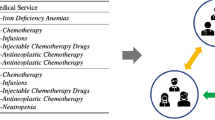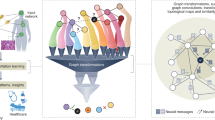Abstract
The variety and dimensionality of health-related data cannot be addressed by the human perception to arrive at useful knowledge or conclusions for proposing individualized treatment, diagnosis, or prognosis for a disease. Treating this wealth of heterogeneous data in a tabular manner deprives us of the knowledge that is hidden in interactions between the different types of data. In this paper, the potentials of graph-based data modeling and management are explored. Entities such as patients, encounters, observations, and immunizations are structured as graph elements with meaningful connections and are, consequently, encoded to form graph embeddings. The graph embeddings contain information about the graph structure in the vicinity of the node. This vicinity contains multiple low-level graph embeddings that are further encoded into a single high-level vector for utilization in downstream tasks by applying higher-order statistics on Gaussian Mixture Models With reference to the Covid-19 pandemic, we make use of synthetic data for predicting the risk of a patient’s fatality with a focus to prevent hospital overpopulation. Initial results demonstrate that utilizing networks of health data entities for the generation of compact medical representations has a positive impact on the performance of machine learning tasks. Since the generated Electronic Health Record vectors are label independent, they can be utilized for any classification or clustering task words.
Access this chapter
Tax calculation will be finalised at checkout
Purchases are for personal use only
Similar content being viewed by others
References
Ghassemi, M., Naumann, T., Schulam, P., Beam, A.L., Chen, I.Y., Ranganath, R.: A review of challenges and opportunities in machine learning for health. AMIA Jt Summits Transl, Sci, Proc, 2020, 191–200 (2020)
Xiao, C., Choi, E., Sun, J.: Opportunities and challenges in developing deep learning models using electronic health records data: a systematic review. J. Am. Med. Inf. Assoc.: JAMIA 25, 1419–1428 (Oct2018)
Lee, D., Jiang, X., Yu, H.: Harmonized representation learning on dynamic EHR graphs. J. Biomed. Inform. 106, 103426 (2020)
Poongodi, T., Sumathi, D., Suresh, P., Balusamy, B.: Deep learning techniques for electronic health record (EHR) analysis. In: Bhoi, A.K., Mallick, P.K., Liu, C.-M., Balas, V.E. (eds.) Bio-inspired Neurocomputing. SCI, vol. 903, pp. 73–103. Springer, Singapore (2021). https://doi.org/10.1007/978-981-15-5495-7_5
Dong, Y., Chawla, N.V., Swami, A.: Metapath2vec: scalable representation learning for heterogeneous networks. In: Proceedings of the 23rd ACM SIGKDD International Conference on Knowledge Discovery and Data Mining (KDD 2017). Association for Computing Machinery, New York (2017)
Perronnin, F., Dance, C.: Fisher Kernels on Visual Vocabularies for Image Categorization. In: 2007 IEEE Conference on Computer Vision and Pattern Recognition, pp. 1–8 (2007)
Solares, J.R.A., et al.: Deep learning for electronic health records: a comparative review of multiple deep neural architectures. J. Biomed. Inf. 101, 103337 (2020)
Grohe, M.: Word2vec, node2vec, graph2vec, X2vec: towards a theory of vector embeddings of structured data. In: Proceedings of the 39th ACM SIGMOD-SIGACT-SIGAI Symposium on Principles of Database Systems (PODS 2020) , pp. 1–16. Association for Computing Machinery, New York (2020)
Grover, A., Leskovec, J.: node2vec: scalable feature learning for networks. In: KDD : proceedings. International Conference on Knowledge Discovery & Data Mining, vol. 2016, pp. 855–864 (2016)
Velickovic, P., Fedus, W., Hamilton, W.L., Lio’, P., Bengio, Y., Hjelm, R.D.: Deep Graph Infomax. ArXiv, abs/1809.10341 (2019)
Kipf, T., Welling, M.: Semi-Supervised Classification with Graph Convolutional Networks. ArXiv, abs/1609.02907 (2017)
Velickovic, P., Cucurull, G., Casanova, A., Romero, A., Lio’, P., Bengio, Y.: Graph Attention Networks. ArXiv, abs/1710.10903 (2018)
Klicpera, J., Bojchevski, A., Günnemann, S.: Predict then propagate: graph neural networks meet personalized PageRank. In: ICLR (2019)
Hamilton, W.L., Ying, Z., Leskovec J.: Inductive representation learning on large graphs. In: NIPS (2017)
Schlichtkrull, M., Kipf, T., Bloem, P., Berg, R.V., Titov, I., Welling, M.: Modeling Relational Data with Graph Convolutional Networks. ArXiv, abs/1703.06103 (2018)
Chiang, W., Liu, X., Si, S., Li, Y., Bengio, S., Hsieh, C.: Cluster-GCN: an efficient algorithm for training deep and large graph convolutional networks. In: Proceedings of the 25th ACM SIGKDD International Conference on Knowledge Discovery & Data Mining (2019)
Perozzi, B., Al-Rfou, R., Skiena, S.: DeepWalk: online learning of social representations. In: Proceedings of the 20th ACM SIGKDD International Conference on Knowledge Discovery and Data Mining (KDD 2014) , pp. 701–710. Association for Computing Machinery, New York (2014)
Le, Q., Mikolov, T.: Distributed representations of sentences and documents. In: Proceedings of the 31st International Conference on International Conference on Machine Learning, vol. 32, pp. II-1188–II-1196 (2014)
Bojanowski, P., Grave, E., Joulin, A., Mikolov, T.: Enriching Word Vectors with Subword Information. Trans. Assoc. Comput. Linguist. 5, 135–146 (July2016)
Walonoski, J., et al.: Synthea™ novel coronavirus (COVID-19) model and synthetic data set. Intell.-Based Med. 1, 100007 (2020)
Acknowledgment
This research has been co‐financed by the European Union and Greek national funds through the Operational Program Competitiveness, Entrepreneurship, and Innovation, under the call RESEARCH – CREATE –INNOVATE (project code: MediLudus - Personalized home care based on research has based on game and gamified elements T1EDK-03049).
Author information
Authors and Affiliations
Corresponding author
Editor information
Editors and Affiliations
Rights and permissions
Copyright information
© 2023 IFIP International Federation for Information Processing
About this paper
Cite this paper
Kallipolitis, A., Gallos, P., Menychtas, A., Tsanakas, P., Maglogiannis, I. (2023). Medical Knowledge Extraction from Graph-Based Modeling of Electronic Health Records. In: Maglogiannis, I., Iliadis, L., MacIntyre, J., Dominguez, M. (eds) Artificial Intelligence Applications and Innovations. AIAI 2023. IFIP Advances in Information and Communication Technology, vol 675. Springer, Cham. https://doi.org/10.1007/978-3-031-34111-3_24
Download citation
DOI: https://doi.org/10.1007/978-3-031-34111-3_24
Published:
Publisher Name: Springer, Cham
Print ISBN: 978-3-031-34110-6
Online ISBN: 978-3-031-34111-3
eBook Packages: Computer ScienceComputer Science (R0)





